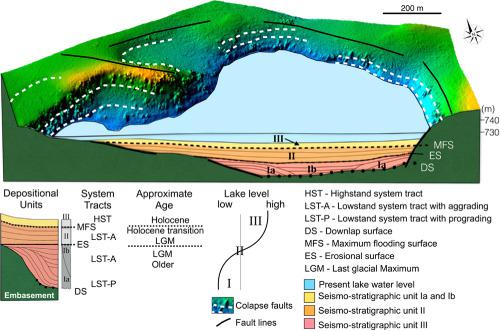当前位置:
X-MOL 学术
›
Earth Surf.Process. Land.
›
论文详情
Our official English website, www.x-mol.net, welcomes your
feedback! (Note: you will need to create a separate account there.)
The role of fault reactivation in the development of tropical montane lakes
Earth Surface Processes and Landforms ( IF 2.8 ) Pub Date : 2020-09-05 , DOI: 10.1002/esp.4997 Pedro Walfir M. Souza‐Filho 1, 2 , Roberto Vizeu L. Pinheiro 2 , Francisco R. Costa 2, 3 , José Tasso F. Guimarães 2 , Prafulla K. Sahoo 1, 4 , Marcio S. Silva 2 , Cleverson G. Silva 5
Earth Surface Processes and Landforms ( IF 2.8 ) Pub Date : 2020-09-05 , DOI: 10.1002/esp.4997 Pedro Walfir M. Souza‐Filho 1, 2 , Roberto Vizeu L. Pinheiro 2 , Francisco R. Costa 2, 3 , José Tasso F. Guimarães 2 , Prafulla K. Sahoo 1, 4 , Marcio S. Silva 2 , Cleverson G. Silva 5
Affiliation

|
This work details the role of fault reactivation in the development of tropical montane lakes by using basin morpho‐structural analysis and seismostratigraphic studies. The upland lakes are severely faulted sinkholes, whose faults penetrate the Quaternary sedimentary units. Four main stages are related to the lake formation: (i) an Early Proterozoic tectonic deformation of the rocks along the southern border of the Carajás Structure, where the lake is placed; (ii) differential erosion by – and building of – the formation of the South Carajás Hill; (iii) Fe‐rich crust formation by weathering and gravitational collapse faults following the E–W plateau border and the start of Violão Lake formation during the Pliocene–Pleistocene; and (iv) episodic fault‐fracture reactivation by gravitational collapse causing pulses of subsidence in the lake and outlining its faulted borders. Dissolution of the lateritic crust and erosion by runoff drainage under wet climate conditions were coeval with fault activities, which allowed the deposition of relatively thick clastic deposits organized in three main seismostratigraphic units associated with major lake‐level fluctuations. Initial fault reactivation under low‐level water started lacustrine basin development with deposition of prograding fan deltas related to the main drainage. A second fault reactivation by gravitational collapse increased the lake accommodation space and resulted in the deposition of fine‐grained sediments from dilute interflows or overflows until 36 000 cal year BP. At about 31 000 cal year BP, rapid decreases in the lake water level under redox conditions at the sediment/water interface allowed widespread siderite formation. A third gravitational collapse episode was responsible for the increase in the lake area and depth and the returning of clastic/organic deposition up to the present. This tropical montane lake can be seen as a representative example for understanding the formation of other upland lakes controlled by fault reactivation. © 2020 John Wiley & Sons, Ltd.
中文翻译:

断层活化在热带山地湖泊发展中的作用
这项工作通过盆地形态结构分析和地震地层学研究,详细说明了断层复活在热带山地湖泊发展中的作用。山地湖泊是严重断层的沉陷坑,其断层穿透第四纪沉积单元。与湖泊形成有关的四个主要阶段:(i)沿湖泊所在的Carajás构造南部边界的岩石的原始元古代构造变形;(ii)南卡拉加斯山地层的形成和建立的不同程度的侵蚀;(iii)在上新世—更新世期间,随着高原高原边界和维奥朗湖形成的开始,由风化和重力塌陷断层形成的富铁结壳;(iv)重力塌陷引起的断层断裂再活化,在湖中引起沉陷脉冲并勾勒出其断层边界。湿润气候条件下,径流排水引起的红土壳的溶解和侵蚀与断层活动同时发生,这使得相对较厚的碎屑沉积物沉积在三个主要的地震地层单元中,这与主要的湖平面波动有关。低水位下的初始断层复活开始了湖盆盆地的发展,沉积了与主排水有关的扇形三角洲。重力塌陷引起的第二次断层复活增加了湖泊的容纳空间,并导致了由稀疏的流向或溢流引起的细粒沉积物的沉积,直到3.6 000 cal BP。在BP大约31 000 cal年,在沉积物/水界面的氧化还原条件下,湖泊水位的快速下降使得广泛的菱铁矿形成。第三次重力坍塌事件是造成湖泊面积和深度增加以及直到现在为止碎屑/有机沉积物恢复的原因。可以将这个热带山地湖视为了解断层复活控制的其他高地湖泊形成的代表。©2020 John Wiley&Sons,Ltd. 可以将这个热带山地湖视为了解断层复活控制的其他高地湖泊形成的代表。©2020 John Wiley&Sons,Ltd. 可以将这个热带山地湖视为了解断层复活控制的其他高地湖泊形成的代表。©2020 John Wiley&Sons,Ltd.
更新日期:2020-11-03
中文翻译:

断层活化在热带山地湖泊发展中的作用
这项工作通过盆地形态结构分析和地震地层学研究,详细说明了断层复活在热带山地湖泊发展中的作用。山地湖泊是严重断层的沉陷坑,其断层穿透第四纪沉积单元。与湖泊形成有关的四个主要阶段:(i)沿湖泊所在的Carajás构造南部边界的岩石的原始元古代构造变形;(ii)南卡拉加斯山地层的形成和建立的不同程度的侵蚀;(iii)在上新世—更新世期间,随着高原高原边界和维奥朗湖形成的开始,由风化和重力塌陷断层形成的富铁结壳;(iv)重力塌陷引起的断层断裂再活化,在湖中引起沉陷脉冲并勾勒出其断层边界。湿润气候条件下,径流排水引起的红土壳的溶解和侵蚀与断层活动同时发生,这使得相对较厚的碎屑沉积物沉积在三个主要的地震地层单元中,这与主要的湖平面波动有关。低水位下的初始断层复活开始了湖盆盆地的发展,沉积了与主排水有关的扇形三角洲。重力塌陷引起的第二次断层复活增加了湖泊的容纳空间,并导致了由稀疏的流向或溢流引起的细粒沉积物的沉积,直到3.6 000 cal BP。在BP大约31 000 cal年,在沉积物/水界面的氧化还原条件下,湖泊水位的快速下降使得广泛的菱铁矿形成。第三次重力坍塌事件是造成湖泊面积和深度增加以及直到现在为止碎屑/有机沉积物恢复的原因。可以将这个热带山地湖视为了解断层复活控制的其他高地湖泊形成的代表。©2020 John Wiley&Sons,Ltd. 可以将这个热带山地湖视为了解断层复活控制的其他高地湖泊形成的代表。©2020 John Wiley&Sons,Ltd. 可以将这个热带山地湖视为了解断层复活控制的其他高地湖泊形成的代表。©2020 John Wiley&Sons,Ltd.











































 京公网安备 11010802027423号
京公网安备 11010802027423号